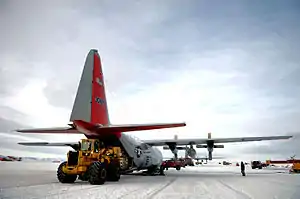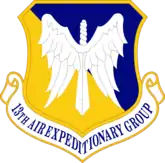13th Air Expeditionary Group
The 13th Air Expeditionary Group is a provisional United States Air Force unit.
| 13th Air Expeditionary Group | |
|---|---|
 An LC-130 Hercules is unloaded on the ice runway near McMurdo Station, Antarctica, during Operation Deep Freeze. | |
| Active | 1941–1942; after 2003 |
| Country | |
| Branch | |
| Role | Command of expeditionary forces |
| Motto(s) | Alert Day or Night |
| Engagements | Antisubmarine Campaign |
| Insignia | |
| 13th Air Expeditionary Group emblem[1] |  |
| 13th Bombardment Group emblem (approved 2 January 1942)[2] |  |
History
World War II
The group was first activated at Langley Field, Virginia in January 1941 as the 13th Bombardment Group, with the 39th, 40th, and 41st Bombardment Squadrons assigned and the 3d Reconnaissance Squadron attached. The group was equipped with a mix of Douglas B-18 Bolos and North American B-25 Mitchells. In June, the group moved to Orlando Army Air Base, Florida.[2][3][4][5][6]
After the attack on Pearl Harbor, the group was ordered to search for German U-boats off the southeast coast. Although the Navy was responsible for long range patrolling, it lacked the aircraft to perform the mission and the Army Air Forces (AAF) performed the mission, even though its crews lacked proper training.[7] As antisubmarine warfare assets were realigned to meet the growing threat in the North Atlantic, the 13th Group moved to Westover Field, Massachusetts in January 1942.[2] The following month, the 3d Reconnaissance Squadron was assigned to the group, and, in April, became the 393d Bombardment Squadron.[6]
In October 1942, the AAF organized its antisubmarine forces into the single Army Air Forces Antisubmarine Command, which established the 25th Antisubmarine Wing the following month to control its forces operating over the Atlantic.[8][9] Its bombardment group headquarters, including the 13th, were inactivated.[2]
Expeditionary operations
The group was converted to provisional status, redesignated the 13th Air Expeditionary Group and assigned to Pacific Air Forces to activate or inactivate as needed. It has been used primarily to control operations or exercises for Thirteenth Air Force. This has included acting as the air component of Joint Task Force-Support Forces Antarctica. The group commander is dual hatted as the deputy commander, JTF-SFA.[1][10]
Lineage
- Constituted as the 13th Bombardment Group (Medium) on 20 November 1940
- Inactivated on 30 November 1942[11]
- Redesignated 13th Air Expeditionary Group and converted to provisional status
- Activated 2 October 2003[12]
- Inactivated 31 October 2003[12]
- Activated 2 February 2004 for Exercise Balikatan 04[13]
- Inactivated 1 April 2004[14]
- Activated 5 February 2004 for Exercise Cope Tiger 04[13]
- Inactivated 9 March 2004[15]
- Activated 11 January 05 for Exercise Cope Tiger 05[16]
- Inactivated 8 February 2005[17]
- Activated 30 January 2006 for Exercise Cope Tiger 06[18]
- Inactivated c. February 2006[19]
- Activated c. January 2007 for Exercise Cope Tiger 07[20]
- Inactivated 13 February 07[21]
- Activated 10 June 2007 for Exercise Talisman Saber 07[22]
- Inactivated c. June 2007[22]
- Activated 18 August 2007 for Exercise Pacific Airlift Rally 07[23]
- Inactivated 26 August 2007[23]
- Active for Operation Deep Freeze c. 30 November 2007[1]
- Activated 11 January 2008 for Exercise Balikatan 08[24]
- Inactivated 31 March 2008[25]
- Activated 14 January 2008 for Exercise Cope Tiger 08[24]
- Inactivated 13 February 08[26]
- Activated c. March 2009 for Exercise Cope Tiger 09[27]
- Inactivated 3 April 2009[28]
- Activated 1 February 2010 for Exercise Balikatan Sagip 10[29]
- Inactivated 24 February 2010[29]
- Activated 24 February 2010 for Exercise Cope Tiger 10[29]
- Inactivated 16 March 2010[30]
- Active c. 8 November 2010[10]
- Activated 7 March 2012 for Exercise Cope Tiger 11[31]
- Inactivated 4 April 2012[32]
- Activated 9 April 2012 for Exercise Balikatan 2012[32]
- Inactivated 30 April 2012[32]
- Active c. 12 November 2015[33]
Assignments
- First Air Force, 15 January 1941
- I Bomber Command, 6 June 1941
- Army Air Forces Antisubmarine Command, 15 October–November 1942
- Pacific Air Command to activate or inactivate as needed
- Attached to Thirteenth Air Force, 2 October 2003 – 31 October 2003[12]
- Attached to Thirteenth Air Force, 2 February 2004 – 1 April 2004[13][14]
- Attached to Thirteenth Air Force, 5 February 2004 – 9 March 2004[13][15]
- Attached to Thirteenth Air Force, 11 January 2005 – 8 February 2005[16][17]
- 13th Air Expeditionary Task Force, 30 January 2006-c. February 2006[18][19]
- 13th Air Expeditionary Task Force, c. January 2007 – 13 February 2007[20][21]
- Attached to Thirteenth Air Force, 10 June 2007-c. June 2007[22]
- 13th Air Expeditionary Task Force, 18 August 2007 – 26 August 2007[23]
- Attached to Thirteenth Air Force, 11 January 2008 – 31 March 2008[24][25]
- 13th Air Expeditionary Wing, 14 January 2008 – 13 February 2008[24][26]
- Joint Task Force-Support Forces Antarctica c. 30 November 2008[1]
- 13th Air Expeditionary Wing, c. March 2009-3 April 2009[27][28]
- Attached to Thirteenth Air Force, 1 February 2010 – 24 February 2010[29]
- 13th Air Expeditionary Wing, 24 February 2010 – 16 March 2010[29][30]
- Joint Task Force-Support Forces Antarctica c. 8 November 2010[10]
- 13th Air Expeditionary Wing, 7 March 2012 – 4 April 2012[31][32]
- Attached to Thirteenth Air Force, 9 April 2012– 30 April 2012[32]
- Joint Task Force-Support Forces Antarctica c. 12 November 2015[33]
Components
- 39th Bombardment Squadron: 15 January 1941 – 30 November 1942[3]
- 40th Bombardment Squadron: 15 January 1941 – 30 November 1942[4]
- An air echelon was attached to the: Caribbean Sea Frontier, United States Navy, 30 August – 9 October 1942 and 16 October – 15 November 1942
- An air echelon was attached to the: 99th Bombardment Squadron, 9–16 October 1942
- 41st Bombardment Squadron: 15 January 1941 – 30 November 1942[5]
- 3d Reconnaissance Squadron (later 393d Bombardment Squadron): attached 15 January 1941 – 25 February 1942, assigned 25 February – 30 November 1942[6]
- 304th Expeditionary Airlift Squadron, c. 30 November 2007[1]
- 139th Expeditionary Airlift Squadron, c. 30 November 2007[1]
Stations
- Langley Field, Virginia, 15 January 1941
- Orlando Army Air Base, Florida, c. 6 June 1941
- Westover Field, Massachusetts, 20 January – 30 November 1942[11]
- Andersen Air Force Base, Guam, 2 October 2003 – 31 October 2003[12]
- Clark Field, Philippines, 2 February 2004 – 1 April 2004[13][14]
- Korat Royal Thai Air Force Base, Thailand, 5 February 2004 – 9 March 2004[13][15]
- Korat Royal Thai Air Force Base, Thailand, 11 January 2005 – 8 February 2005[16][17]
- Korat Royal Thai Air Force Base, Thailand, 30 January 2006-c. February 2006[18][19]
- Korat Royal Thai Air Force Base, Thailand, c. January 2007 – 13 February 2007[20][21]
- Brisbane International Airport, Australia, 10 June 2007-c. June 2007[22]
- Halim Air Base, Indonesia, 18 August 2007 – 26 August 2007[23]
- Clark International Airport, Philippines, 11 January 2008 – 31 March 2008[24][25]
- Udon Thani Thailand, 14 January 2008 – 13 February 2008[24][26]
- Korat Royal Thai Air Force Base, Thailand, c. March 2009-3 April 2009[27][28]
- Diosdado Macapagal International Airport, Philippines, 1 February 2010 – 24 February 2010[29]
- Udon Thani Thailand, 24 February 2010 – 16 March 2010[29][30]
- Udon Thani Thailand, 7 March 2012 – 4 April 2012[31][32]
- Clark Field, Philippines, 9 April 12–30 April 12[32]
References
Notes
- No byline (30 November 2007). "13th Air Expeditionary Group adopts new emblem". 13th Air Force Public Affairs. Archived from the original on 22 July 2011. Retrieved 12 October 2018.
- Maurer, Combat Units, pp. 56–57
- Maurer, Combat Squadrons, p. 768
- Maurer, Combat Squadrons, pp. 25–26
- Maurer, Combat Squadrons, pp. 771–772
- Maurer, Combat Squadrons, pp. 37–38
- Ferguson, p. 4
- Maurer, Combat Units, p. 437
- Maurer, Combat Units, pp. 388–389
- Cragg, LT (USN) Jennifer (8 November 2010). "Military supports the U.S. Science Foundation in Antarctica". Air Force Print News Today. Archived from the original on 12 March 2012. Retrieved 12 October 2018.
- Lineage, including stations, through 1942 in Maurer, Combat Units, pp. 56–57
- Research Division, Air Force Historical Research Agency, Air Force Organization Change Status Report, October 2003, Maxwell AFB, AL
- Research Division, Air Force Historical Research Agency, Air Force Organization Change Status Report, February 2004, Maxwell AFB, AL
- Research Division, Air Force Historical Research Agency, Air Force Organization Change Status Report, April 2004, Maxwell AFB, AL
- Research Division, Air Force Historical Research Agency, Air Force Organization Change Status Report, March 2004, Maxwell AFB, AL
- Research Division, Air Force Historical Research Agency, Air Force Organization Change Status Report, January 2005, Maxwell AFB, AL
- Research Division, Air Force Historical Research Agency, Air Force Organization Change Status Report, February 2005, Maxwell AFB, AL
- Research Division, Air Force Historical Research Agency, Air Force Organization Change Status Report, January 2006, Maxwell AFB, AL
- Research Division, Air Force Historical Research Agency, Air Force Organization Change Status Report, February 2006, Maxwell AFB, AL
- Research Division, Air Force Historical Research Agency, Air Force Organization Change Stat+us Report, January 2007, Maxwell AFB, AL
- Research Division, Air Force Historical Research Agency, Air Force Organization Change Status Report, February 2007, Maxwell AFB, AL
- Research Division, Air Force Historical Research Agency, Air Force Organization Change Status Report, June 2007, Maxwell AFB, AL
- Research Division, Air Force Historical Research Agency, Air Force Organization Change Status Report, August 2007, Maxwell AFB, AL
- Research Division, Air Force Historical Research Agency, Air Force Organization Change Stat+us Report, January 2008, Maxwell AFB, AL
- Research Division, Air Force Historical Research Agency, Air Force Organization Change Status Report, March 2008, Maxwell AFB, AL
- Research Division, Air Force Historical Research Agency, Air Force Organization Change Status Report, February 2008, Maxwell AFB, AL
- Research Division, Air Force Historical Research Agency, Air Force Organization Change Status Report, March 2009, Maxwell AFB, AL
- Research Division, Air Force Historical Research Agency, Air Force Organization Change Status Report, April 2009, Maxwell AFB, AL
- Research Division, Air Force Historical Research Agency, Air Force Organization Change Status Report, February 2010, Maxwell AFB, AL
- Research Division, Air Force Historical Research Agency, Air Force Organization Change Status Report, March 2010, Maxwell AFB, AL
- Research Division, Air Force Historical Research Agency, Air Force Organization Change Status Report, March 2012, Maxwell AFB, AL
- Research Division, Air Force Historical Research Agency, Air Force Organization Change Status Report, April 2012, Maxwell AFB, AL
- Lucibella, Michael (12 November 2015). "Two Nations Honor Their Veterans". United States Antarctic Program: The Antarctic Sun. Retrieved 12 October 2018.
Bibliography
![]() This article incorporates public domain material from the Air Force Historical Research Agency website http://www.afhra.af.mil/.
This article incorporates public domain material from the Air Force Historical Research Agency website http://www.afhra.af.mil/.
- Ferguson, Arthur B. (April 1945). "The Antisubmarine Command, USAF Historical Study No. 107" (PDF). Assistant Chief of Air Staff, Intelligence Historical Division. Retrieved 12 September 2016.
- Maurer, Maurer, ed. (1983) [1961]. Air Force Combat Units of World War II (PDF) (reprint ed.). Washington, DC: Office of Air Force History. ISBN 0-912799-02-1. LCCN 61060979. Retrieved 17 December 2016.
- Maurer, Maurer, ed. (1982) [1969]. Combat Squadrons of the Air Force, World War II (PDF) (reprint ed.). Washington, DC: Office of Air Force History. ISBN 0-405-12194-6. LCCN 70605402. OCLC 72556. Retrieved 17 December 2016.
.jpg.webp)